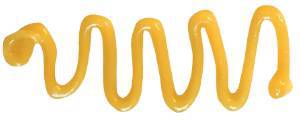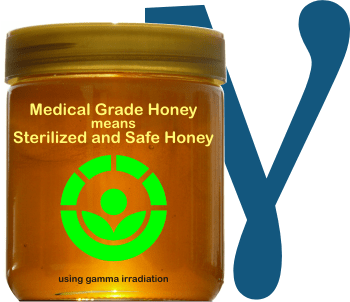Wounds that never heal? Bacterial infection? Not any more. Use medical grade honey to treat your wound. Here is a Medihoney wound dressing review, that explains how it functions and what to do.
MEDIHONEY® is the global leading brand of wound care dressings, made with manuka honey, also known as Active Leptospermum Honey, from the botanical name of the bush, the source of this honey. Manuka honey is different than the other honeys, and research confirmed that it is the best for wounds and skin infections.
 Producer:
Producer:
MEDIHONEY® is a trademark of Comvita New Zealand Ltd and is used with permission by Derma Sciences, Inc.DERMA SCIENCES INC., a company specialized in tissue regeneration, well-known for its research and innovation for the management of acute and chronic wounds, and burns.
Products:
– MEDIHONEY® – medical-grade honey products for the management of wounds and burns.
– XTRASORB® – super-absorbent wound dressings
– ALGICELL® Ag – Antimicrobial silver dressings in absorbent/gelling formats have become the leading category of “active” moist wound dressings worldwide
– TCC-EZ® – a one-piece, roll-on, woven design that simplifies the application process while reducing the potential for causing additional tissue damage. Also known as the Gold Standard of Care for off-loading diabetic foot ulcers.
Medihoney Antibacterial Wound Gel™
How does it work?
• Aids in autolytic debridement due to its high osmolarity
• Helps to lower overall wound pH
• Promotes a moisture-balanced environment conducive to wound healing
How to use it on the wound:
– Clean: Clean the wound with saline water.
– Apply: Directly apply the honey gel to the wound bed. Ensure it is in full contact with the wound bed and has approximately 3mm thickness. It is recommended to pair MEDIHONEY® with XTRASORB®, which is a super absorbent cover dressing. It’s osmotic gradient pulls exudate to the back of the dressing and converts it into a gel, locking it away – even under compression!
Whatever you choose, the secondary dressing should be sufficiently absorbent to accommodate the volume of wound exudate.
– Change: Periodically change the dressing. Do it gently. If the dressing is dry and sticking to the wound bed, moisten it first with normal saline or sterile water. Generally, this antibacterial gel can be left on the wound for up to 7 days depending on the exudate levels. The frequency of changing depends a lot of the amount of drainage coming from your wound. If there is a lot of fluid and the dressing becomes saturated, it may need to be changed more frequently.
Keep in mind that:
• Initially there may be an increase of fluid from the wound and the dressing might become easily saturated. It is important to absorb this moisture or any excess moisture and protect the surrounding skin from becoming wet and macerated. You may add an absorptive cover dressing and/or increase the frequency of dressing change, in addition to applying a protective skin barrier film to the skin around the wound.
• The wound may look larger in the beginning. This happens because of the dead tissue that is removed. However, the wound should stop increasing after the first few dressing changes.
PROs
• It can be used for both adults and children;
• It can be used by diabetics. The high sugar content in MEDIHONEY® has a beneficial osmotic effect, helping the body’s natural processes to cleanse the wound and remove dead tissue. A regular use of MEDIHONEY® on diabetic foot ulcers has not been shown to alter glucose levels during routine monitoring;
• Some wounds cannot heal because of their infection with some bacteria, which are hard to kill. The very well known “antibiotic resistant bacteria” like MRSA, ESBL, VRE, Acinetobacter, Pseudomonas aeruginosa can be effectively killed with Medihoney Antibacterial Wound Gel™;
• At dressing change, the trauma and pain is reduced due to the moist would healing environment honey provides;
• It shortens the time of healing;
• Takes away the bad odor of the wound (especially if it’s an old one);
• Is non-toxic, natural and safe;
• It can be left on the wound up to 7 days (depending on the level of exudates).
CONs
• A stinging experience can be felt when MEDIHONEY® is applied, due to the difference between the high pH of the wound and low pH of honey;
• Sometimes pain can also be associated with the stinging sensation. In this case your healthcare provider may suggest an analgesic which should be taken approximately 30 minutes before your dressing is changed;
• You cannot use it if you have a known sensitivity to honey, algae or seaweed;
• It cannot be used to control heavy bleeding;
• It cannot be used on third degree burns.
MEDIHONEY®Antibacterial Wound Gel
available on Amazon
This product also comes in a paste form. Some people consider it to be easier to apply. I personally see no difference. Here are the main differences between the two:
Gel
|
Paste
|
| • 80% Active Leptospermum Honey and 20% Natural Gelling agents • More viscous formulation with increased stability at the site of the wound • Demonstrated positive clinical outcomes • Optimal for superficial to full thickness wounds |
• 100% Active Leptospermum Honey • Demonstrated positive clinical outcomes • Optimal for deep tunneled or undermined wounds |

Derma Sciences 31505 Medihoney Dressing Paste, 0.5 oz Tube (Pack of 10), on Amazon
To protect the wound we cannot simply apply the gel and leave the wound uncovered. It is recommended to use an absorbent, and MEDIHONEY® offers the perfect solution: XTRASORB®. A super-absorbent cover dressing, which comes in three different types, according to your wound.
♦ XTRASORB® HCS: For dry to moderately exuding wounds – with and without adhesive border
♦ ♦ XTRASORB® Foam: For moderately to heavily exuding wounds – with and without adhesive border
♦ ♦ ♦ XTRASORB® Classic: For heavily and extra heavily exuding wounds
What’s so special about this absorbent? See the article “XTRASORB® – A product review”.
This is how medihoney works, in a video made by the producer:
Studies:
Medihoney: a complete wound bed preparation product.
Manuka honey used to heal a recalcitrant surgical wound.
Honey and contemporary wound care: an overview.
Using leptospermum honey to manage wounds impaired by radiotherapy: a case series.
The use of honey for the treatment of two patients with pressure ulcers.
*******
*******






